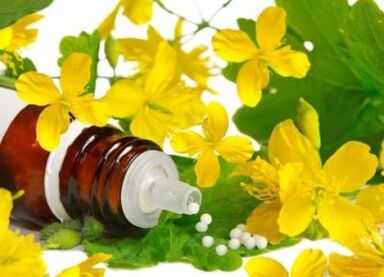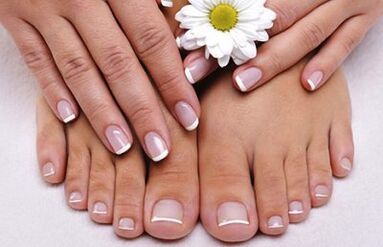Medicinal celandine, or warthog as it's called, is a proven treatment for fungal infections that produces positive results faster than many modern ointments, creams, and aerosols. To answer the question of whether it is possible to treat nail fungus with celandine, one should understand the properties of the plant, which depend on the ingredients that make up its composition.
The properties of celandine and the components that make up the herb
Celandine grass is considered a poisonous plant, secreting an orange milky sap when the stem breaks, which is used to treat fungi. Warthog ingredients include alkaloids—substances that reduce inflammation and destroy pathogenic bacteria. The ingredients also include essential oils, vitamins, natural antibiotics, and plenty of organic acids.
To find out if celandine juice helps nail fungus, let's determine its properties:
- antifungal drugs;
- sterilization;
- anesthetic;
- recovery.
Thanks to the properties listed, celandine can destroy the fungus on the feet, between the toes and nails as quickly as possible. There are many traditional medicine recipes based on celandine that will allow you to fight various types of fungal infections.
celandine treatments

For the preparation of the composition, fresh and hay are used, which are best collected in the spring, because it is during this period that the plants accumulate the greatest amount of nutrients.
However, with celandine from toenail fungus, don't forget about other treatments. The best option for getting rid of a fungal infection is a complex treatment that includes herbal juices, ointments, and creams used to treat the affected area, as well as internal medicine prescribed by your doctor.
Before using celandine to fight toenail fungus, you need to identify the type of ingredients:
- plant juice;
- Alcohol tinctures;
- wart lard;
- decoction;
- Compressed from a mixture of celandine juice and other substances.
Warthog Juice in Folk Medicine
Liquid celandine from the nail fungus can be used as a stand-alone medicine or as part of a recipe.
It's pretty easy to prepare a magic juice that can get rid of fungus. Fresh grass is ground through a meat grinder or in a blender. The gruel is extruded through gauze, which is best folded into several layers. Mix the juice with 70% alcohol in a 1: 1 ratio and soak in a cool place for 24 hours.
The prepared solution can be applied 1-2 times a day on previously cleaned nail plates for several weeks until the nails are fully recovered. You can do compression. The only important thing to remember is that the nails have to breathe.
Use of alcohol tinctures
An alcoholic tincture of celandine is prepared as follows:
- 70% alcohol - 250 ml;
- Celandine Oil - 20 drops.
Mix and infuse these ingredients for about a day.
For the treatment of foot fungus or fungal disease located between the fingers, you will need to dip a gauze folded in several layers into the tincture and apply it to the infected area.
Treating nail fungus with celandine requires a slight recipe change: add 30 drops of celandine oil to 250 ml of alcohol. But you need to use this solution very carefully and try not to get it on your skin. To apply layers, you can use a brush or cotton swab.
Before using the product, the legs must be fully steamed in the bath (about 10-15 minutes), dried and cleaned of keratinized particles from the skin or nails. Only then can the treatment solution be applied. Results will appear after 10-14 days.
Celandine oil for fungal infections

Treating toenail fungus with celandine oil produces quick and long-lasting results. In this case, the drug can be prepared independently or purchased at a pharmacy. The price of a drug depends on its packaging and the manufacturer's pricing policy.
For self-preparation, you need to take the stems and leaves of the plant, preferably dry. Warthogs are packed tightly in jars and poured with vegetable oil, preferably olive or almond oil. When using sunflower oil, it should be heated slightly in a water bath. Refined oils are not suitable for use in the preparation of the product. The oil layer above the grass should be about 1-2 cm. Take out the airtight jar and keep it in a cool place away from light for 7-10 days. The mixture must then be filtered and diluted with an equal amount of oil.
Celandine oil prepared in this way from the nail fungus is used in many recipes. For example, lemon and celandine oil mix: 1-2 drops of lemon juice per 2 tablespoons of medicine. This reagent is suitable for areas damaged by fungi.
Lemon and celandine soften the nails, allowing you to gently exfoliate the cuticle with a scalpel. At the same time, the sap of the plant seeps deep into the nail plate and begins to exert a healing effect.
A mixture of vinegar and celandine can be used when it is necessary to soften the nail plate before applying a medicated ointment. Mix two tablespoons of oil with 2-3 drops of 3% vinegar and apply as a compress to the affected area.
Before applying the mixture, it is necessary to steam the nails, dry and wipe the affected area with hydrogen peroxide. After the peroxide has dried, apply a thin layer of celandine oil. The duration of treatment depends on how quickly the skin or nails recover.
Treatment with infusions and decoctions
Fungus on the feet, fingers and nails is well treated with the help of a bath of warthog infusion. Recipe: Pour 5 tablespoons of dried herbs into 6 cups of water. The mixture must be boiled and diluted with cold water to the desired temperature. The duration of the program is 30 minutes. After steaming, lubricate the problem area with an antifungal ointment or cream. Internally combined ingestion of antifungal drugs produces good results.
To prepare the decoction, it is necessary to collect fresh celandine flowers and fill them with water so that the liquid is 3 cm above the level where the flowers are placed. According to the recipe, the water should boil. The composition was infused for five days and filtered through gauze folded into several layers.
The finished product is mixed 1: 1 with olive oil, vegetable oil or iodine. Before applying the product to the nails, they need to be boiled and cleaned. The procedure should be performed 2-3 times a day for at least 2 weeks. At night, you can compress with decoction.
Celandine Compress
A unique formula that promotes the rapid recovery of nail plates damaged by fungi is a blend of iodoethanol and celandine. A liquid slurry was prepared from crushed hay, and iodohydrin was gradually added. Place the resulting chunk on the nail and cover with cellophane. Compression should be held for at least 20 minutes. Fingers should not get wet for 3-4 hours after cleaning them. This procedure takes place every day.
The compress is anti-fungal and softens the nail plate well. The latter property applies to advanced forms of the disease. With the development of onychomycosis, the nails thicken, deform, change their structure, and reduce tissue permeability. After softening and compression, the affected panels were well cleaned of keratinized particles. And the ointment applied to the affected area is better absorbed and works faster.
Compression can be done at night and only removed in the morning. Afterwards, steam your nails in hot water with laundry soap or soda. Apply ointment or varnish to manicured and clean nails.
How to avoid reinfection
This fungus is difficult to treat. Therefore, it is important to prevent the recurrence of the disease.
Precautions to avoid reinfection:
- Refusing to wear other people's shoes, socks, or use other people's towels;
- Make sure your legs don't sweat a lot;
- Do not walk barefoot in baths, saunas, swimming pools;
- Feet should be washed daily with soap.
The fungus begins to develop and the immunity is weak. Therefore, it is recommended to drink vitamins and monitor the diet.

























